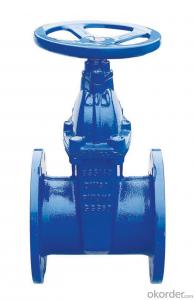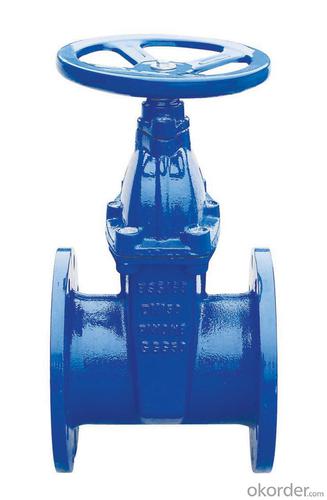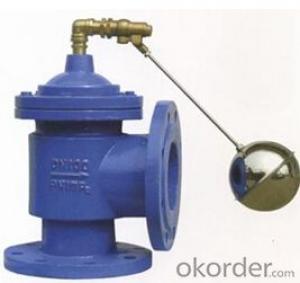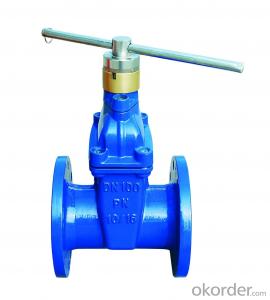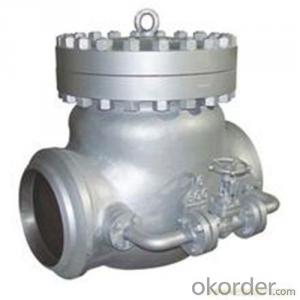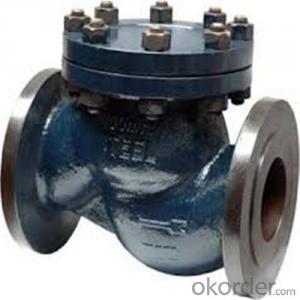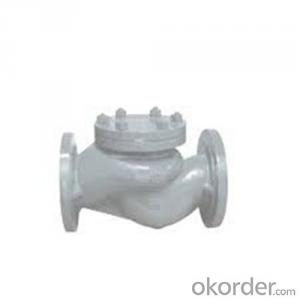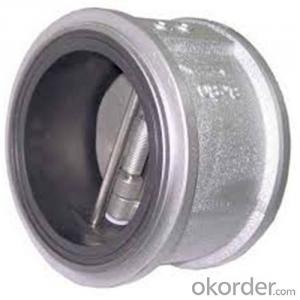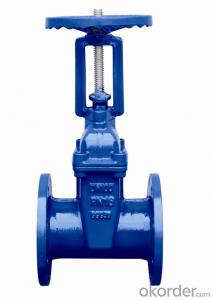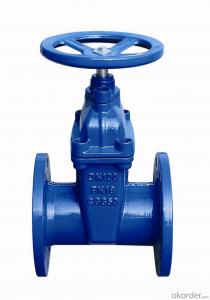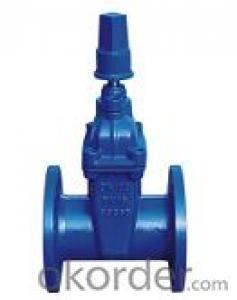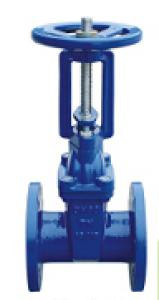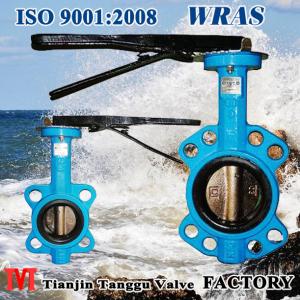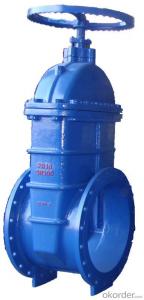Non-rising Resilient Sluice Valve BS5163 DN350
- Loading Port:
- Tianjin
- Payment Terms:
- TT OR LC
- Min Order Qty:
- 100 set
- Supply Capability:
- 10000 set/month
OKorder Service Pledge
OKorder Financial Service
You Might Also Like
1.Structure of Gate Valve Description:
A gate valve, also known as a sluice valve, is a valve that opens by lifting a round or rectangular gate/wedge out of the path of the fluid. The distinct feature of a gate valve is the sealing surfaces between the gate and seats are planar, so gate valves are often used when a straight-line flow of fluid and minimum restriction is desired. The gate faces can form a wedge shape or they can be parallel. Gate valves are primarily used to permit or prevent the flow of liquids, but typical gate valves shouldn't be used for regulating flow, unless they are specifically designed for that purpose.
2. Main Features of the Gate Valve:
•Valve body cavity using nontoxic epoxy resin,both inside and outside flashboard completely is coated with rubbe
• Free of water pollution
• High manufacturing accuracy
• High strength
• Environmental protection and energy saving
• Good visual effect
• Small fluid resistance >
3. Images


4. Gate valve Specification
1.Nominal Pressure:1.6MPa
2.Suitable Medium :Water,Saturated Steam,Oil, Gas
3.Working Temperature:-20 ≤ t ≤180
4.Thread : ISO 07
5.Solder Socket To ANSI B16/18
6.Size: 1/2" ~ 2"
7.Delivery: In 30 Days
5.FAQ
1. What's are the characteristics of gate valve?
The distinct feature of a gate valve is the sealing surfaces between the gate and seats are planar, so gate valves are often used when a straight-line flow of fluid and minimum restriction is desired. The gate faces can form a wedge shape or they can be parallel.
2. What is the work principle of gate valve ?
The gate faces can form a wedge shape or they can be parallel. Gate valves are primarily used to permit or prevent the flow of liquids, but typical gate valves shouldn't be used for regulating flow, unless they are specifically designed for that purpose. Because of their ability to cut through liquids, gate valves are often used in the petroleum industry.
3. What is the structure?
Bonnets provide leakproof closure for the valve body. Gate valves may have a screw-in, union, or bolted bonnet. Screw-in bonnet is the simplest, offering a durable, pressure-tight seal. Union bonnet is suitable for applications requiring frequent inspection and cleaning. It also gives the body added strength. Bolted bonnet is used for larger valves and higher pressure applications.
- Q: The tricuspid valve is closed: a. during the rapid filling of the ventriclesb. when the mitral valve is openc. during ejection of blood from the ventriclesHelp plzThank you!
- c
- Q: I have a Jupiter double horn. The thumb valve will randomly stick down and not want to come back up. It however only does this when I play a scale or am in the middle of a song, so when I ask the director or an instrument repair person to help, they think I'm crazy and see nothing wrong with it. Also, the first valve is slightly bent sideways towards the second valve. I got it used and it came like this. It is not horrible, but that makes it significantly slower than the other valves and sticks a LOT. All repair shops do is take my money and claim they've fixed it when they have done nothing. It is so frustrating. What should I do? And the oil doesn't help with either of these things, which is even MORE frustrating.
- thats easily particularly straightforward for brand spanking new horns, somewhat hand-crafted ones. The valves are nevertheless very tight and there would be steel debris nevertheless interior the tubing/valves from manufacture, it in basic terms desires to be taken to a competent restoration save and wiped clean thoroughly. previously you do this in basic terms attempt putting oil on the lower back and desirable (decrease than valve cap) bearings, and take out each and all the valve slides and positioned some mild oil (Al Cass works constructive) oil into the valve itself. in the event that they nevertheless draw close then take it to be wiped clean. and FYI concert activities on incredibly new horns isn't a competent concept, apart from mechanical subject concerns, you're able to desire to take time to get used to the device and its pitch dispositions. in view that probably is unquestionably no longer your final horn, in basic terms evaluate that next time.
- Q: Is this possible? The valve is way too big to fit the rim. Is there a special inner tube for this rim? Thanks in advance.
- Sounds as if you need a tube with a Presta valve stem vs. a Schrader valve stem. Link below showing the difference.
- Q: okay, so i have a 2003 cr125 that i wanted to trade for a 4 stroke bike, and i found someone with a 2006 kx250f that wants to trade. He said all the bike needs to be running are 4 valves. The bike is in very good condition from the pictures i saw. How much are the 4 valves going to cost if i bring it to a mechanic shop? is the trade worth it? or should i just keep looking? thanks!p.s.- my cr is in absolute mint condition, and i never even rode it because it is just to much bike for me and i am not use to 2 strokes
- keep looking, they never need just valves, if it needs valves, the top end also needs to be rebuilt. when your already going to be in the motor that far, it would suck to get it back together and then the piston goes or something else that was getting abused when the valves were going. if you can`t do the work yourself it will be expensive, even if you can do the work you need to factor in parts, machine shop,and specialty tools. you could set up your cr125 for way less money, and make it work for you, i`ve seen little kids and girls at the races riding 125`s and they can`t touch the ground without blocks. and you`ll love that 2-stroke when it comes time to rebuild it, you could put all the best parts in it and do it yourself for under $300, compared to sometimes over $1500 for 4-stroke, take it from me i`ve done it, i`ve raced 4-strokes since 2001. if your not racing, stay on those 2-strokes for as long as you can, they will make you a better rider anyway, and keep riding, you`ll get used to it :-)
- Q: My husband went to the doctor today, then called to say he won't be coming home because he has infective endocarditis. They sent him to another, larger, hospital in the region. Hours later he called and said that he needs surgery on the valve and they are moving him to another part of the country. I've been trying to read about it but I'm not sure I understand. What I've read says that they have to treat the infection with penicillin first, the he can have surgery. However, he's telling me he might have surgery when he get to the other hospital. He needs a new valve. Does this mean that his condition is worse than those I've read about or that they are simply doing things differently? Also, if you know. Does other illnesses make the risks much higher? He's got aspergillus in his lungs and have had 2/3 of the lungs removed. He has an immune deficiency (HIES) and he is physically weak from being sick. I know it's not good, but how bad is it?
- Infectious endocarditis. Of course, any endocarditis is an infection. Rather like saying an 'infectious cold.' You will need to discuss this with his doctor to get good information. That means you go where he is. If you need to you make an appointment with the doctor at his office to find out. No way to know what kind of heart value issue he has or what other kind of heart condition he has.
- Q: can a person survive with only one heart valve functioning?
- All four valves are not essential. Many patients have Pulmonary regurg after a surgery for Fallot's tetrology. Other three valves are important but valve leaks are better tolerated on the rt side than on the left side. Stenosis of any valve causes obstruction to circulation and so it causes problems.
- Q: Why do we use in chilled water pipe network utilizing 2 way valves on all terminals except the last terminal we use a 3 way valve, also another question what does a pump shutt off pressure means
- A three-way valve on a chiller increases efficiency by allowing return water to mix with a small amount of the water being supplied to the loop. These valves are sometimes mechanical to allow water to recirculate through the chiller to keep the chiller running during low ambient conditions. A pump shut off pressure, is the pressure at which the pump control turns the pump off. If a system needs 60psi to run efficiently, the pump control will be set at 60psi.
- Q: My brother is 32 years old.He has an enlarged heart ,a murmur,high blood pressure and heart regurgitation.He may be having the valve replacement surgery.I was wondering if anyone has had these things wrong with them and had the valve surgery and did well afterwards.Any information would be very much appreciated.
- Guy I work with just had 2 valves replaced. He honestly didn't know anything was a matter until he collapsed at work. They ran some tests and figured out that was his problem. Talked to him a few days after his surgery and he said he hasn't felt this good in a long time. Its a common procedure nowadays, and your brother should most definitely be in good hands. Keep us informed, and best of luck to you both!
- Q: My pressure reducing valve (or restricting valve) was looked at by three master plumbers and they all said I need a new one. My water pressure has been low for weeks. It measures about 100 psi at the outside hose bibs, but it is very low inside and suddenly reduces after you turn on the facets inside. The shower is ok. My automatic sprinkler system is not able to work now due to low pressure. A relative of mine thinks we can just add a handle (as one is missing) on the valve and adjust the pressure ourselves. The repair of the valve is around $500-600! I am told in Texas that we have to have a permit and inspection to repair this valve. Also I was told by the last plumber that came out, that I have to install a expansion tank on my new hot water heater according to code. I'm not sure if that is a city code or federal. Please respond as to information you may have on this problem. The expansion tank is required I'm told when you have a pressure reducing valve for safety, is this true?
- The cost you quoted seems a bit high to me. Mine didn't cost anywhere near that amount in East Texas. A pressure reducing valve acts like a check valve when there is no flow. That is it closes as the pressure rises when you are not using any water. In this condition, the hot water heater can raise the pressure even higher since there is no place for the expanding water to go. That is the reason for the expansion tank. Without the expansion tank the pressure relief valve on the hot water heater can relieve unnecessarily or weep a bit.
- Q: i have a 1996 doge grand caravan,do i need to lower gas tank to remove rear proportioning valve for my brakes, it leaks fluid and is in a bad spot to get too ?
- i got a 97 model van setting out side the shop and i went and looked at it and it doesn't have one on it,what are you calling the rear proportioning valve,it has a block that the lines split off of but not a proportioning valve,let me know if you got some kind of special edition or something,good luck.
Send your message to us
Non-rising Resilient Sluice Valve BS5163 DN350
- Loading Port:
- Tianjin
- Payment Terms:
- TT OR LC
- Min Order Qty:
- 100 set
- Supply Capability:
- 10000 set/month
OKorder Service Pledge
OKorder Financial Service
Similar products
Hot products
Hot Searches
Related keywords
